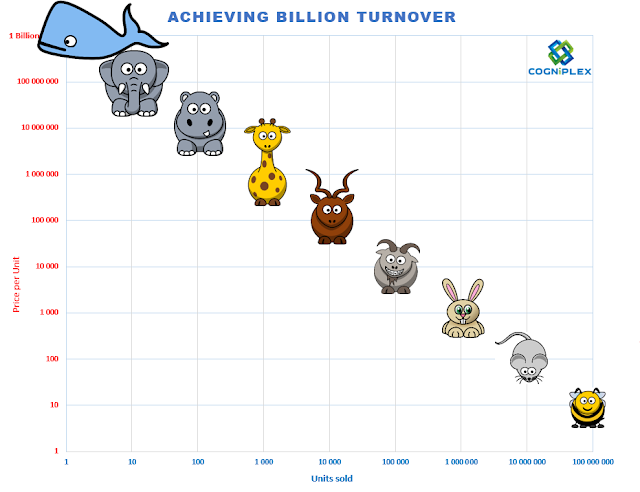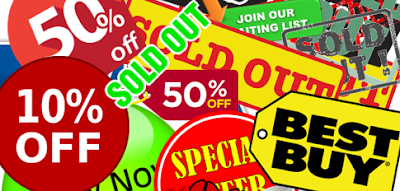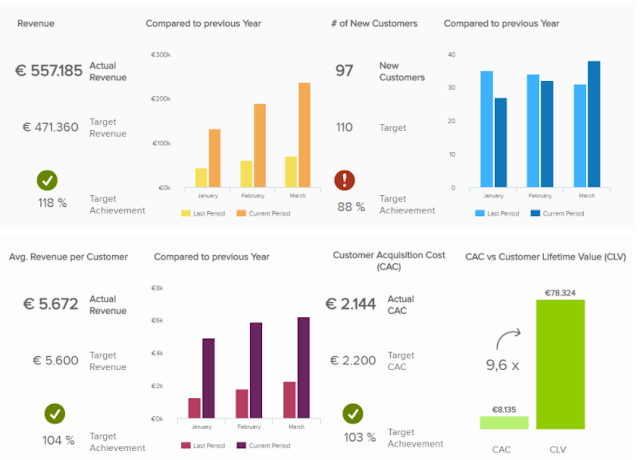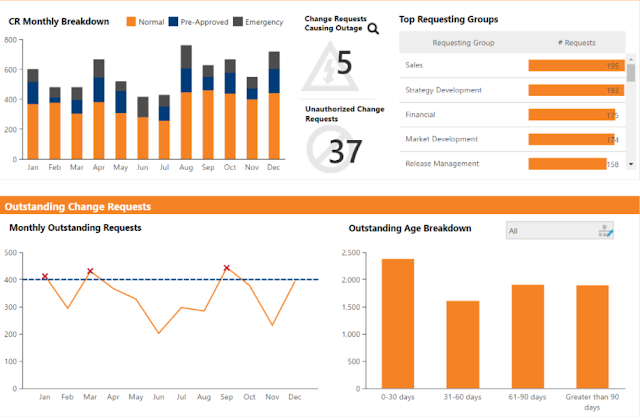30 Different Ways to Build a Billion Business (Part 2)
28 Oct 2017
Abstract
This post is the 2nd part in series of blog posts focussing on various approaches to increase company revenue/turnover and discusses each in brief.
If you have not yet read the 1st post - we highly recommend that you do for context. You can find it here: 30 different ways to build a 1 billion business (Part 1)
In these blog posts, some well-known international and potentially lesser known examples from South Africa or neighbouring countries are included. These blog articles are aimed at business readers, ranging from corporate executives to entrepreneurs and founders searching for strategies to increases revenue. It is equally suitable for interested parties who wish improve their general knowledge around strategies and growth.
If you have not yet read the 1st post - we highly recommend that you do for context. You can find it here: 30 different ways to build a 1 billion business (Part 1)
In these blog posts, some well-known international and potentially lesser known examples from South Africa or neighbouring countries are included. These blog articles are aimed at business readers, ranging from corporate executives to entrepreneurs and founders searching for strategies to increases revenue. It is equally suitable for interested parties who wish improve their general knowledge around strategies and growth.
The full series will contain 3 or 4 articles.
Estimated reading time: 8 min or less
============
0. Background
In Part 1 of this blog, we looked at the roles of the following factors in achieving revenue target:
1. Product & Market Mix
2. Price
In this blog, we continue our journey.
3 Change sales volume
3.1 Sell more units per transaction to increase volume
Selling more units results in higher total sales. One technique to increase sales volume is called Bundling. Bundling is the combining goods and or services in a package deal – sold together. The package deal is typically sold for a marginally lower price than when the component parts are purchased individually. This, in turn, increases turnover. Typical examples include McDonald's Meals, which include a drink, chips (Americans call them fries), and burger, or Office type software including a word processor, spreadsheet as well as presentation application in one package deal.
Once McDonald's introduced the bundled meal concept to SA, other fast food retailers were fast to cotton on and cashed in on the same concept. Now, most offer their own variation on the same idea.
Bundling works well then there are benefits of scale in terms of production or distribution, or when production set-up costs or customer acquisition costs are high.
3.2 Sell more frequently
Increasing the frequency means finding an effective way to shorten the intervals between procuring of goods or services. If customers ordinarily on average visit your restaurant once every 3 months, develop a strategy to bring them back once per month or more. If they check in monthly, bring them back weekly.
 |
| Fig 1.1 Can't get enough Starbucks |
It is important to note that purchase frequency varies between industries – while it is very plausible to see the same customer week after week in a Starbucks coffee shop, it is highly unlikely that the same customer will buy brand new furniture or a new car every month, or even every year. In that case, the program will be focussed on bringing the customer back to the same supplier, once he is ready to buy another vehicle.
3.3 Sell over a longer period
Another way in which increased sales could be achieved is to start subscription-based services, in terms of which fixed monthly payments are charged for a pre-defined service. Cell phone or mobile subscription fees are a good example of this. Users pay the same basic amount based on a pre-defined usage level over a fixed period – locally that is around 2 years.
Maintenance plans sold with new vehicles is another way in which the customer can be tied into a specific brand for a defined number of years, or until as they sell the vehicle.
Yet a further variation on the same theme is SaaS (Software-as-a-Service), or PaaS (Platform-as-a-Service) type software such as DropBox, SalesForce or Slack.
This is, therefore, a pay for usage and availability basis rather than paying for ownership and the rights and obligations that go with that. This is again a demand vs supply consideration. If you were to sell specific software, there could be X users who might be interested in purchasing it at the full sales price. On a SaaS-basis the price to use the software could be cheaper, and availability guaranteed. This could, therefore, increase the number of users compared to the traditional ownership model. SalesForce specifically has shown very strong growth and reached $10 billion annual sales in Aug 2017
- Under the traditional sales model, your would buy software for use on your PC or Mac or deployment on the company servers.
- On the SaaS-basis you would subscribe to use the same software, which is based in a cloud.
- In essence, as a user one has access to all the same functionality you would have had, had you bought the actual software bundle and installed it on locally.
- Key differences are that the software remains on the cloud, and typically no significant software installation happens on locally.
- Pricing is substantially lower compared to outright purchase, but the user is tied to usage conditions around the number of users or volume of allowable usage, in return for a perpetual rental fee.
- Ownership normally also does not transfer to the user.
- The user usually has to some extent the option to decide the period of the rental.
 |
| Fig 1.2 SalesForce Pricing |
This is, therefore, a pay for usage and availability basis rather than paying for ownership and the rights and obligations that go with that. This is again a demand vs supply consideration. If you were to sell specific software, there could be X users who might be interested in purchasing it at the full sales price. On a SaaS-basis the price to use the software could be cheaper, and availability guaranteed. This could, therefore, increase the number of users compared to the traditional ownership model. SalesForce specifically has shown very strong growth and reached $10 billion annual sales in Aug 2017
3.4 Offer volume/quantity discounts
Volume discounts are incentives offered to customers that result in a reduced price per unit, subject to taking a specific number of units of the same product. Buy 5-for-the-price-of-3 is an example of a volume discount offered in the consumer market.
Commercial or industrial buyers might have tiered discount structures where the discount is directly tied to the volume procured – once a specific tier is achieved pricing might reduce further.
3.5 Offer frequent buyer discounts or other forms of customer loyalty programs
Frequent buyer discounts is a further approach to retain and reward customer loyalty. These programs come in many forms, one of which is frequent flyer programmes which entitle customers to further discounts. It is also worth noting that these types of programmes further tie in the buyer – the likelihood of next purchase increases if it counts towards a perceived real future benefit.
Ster Kinekor (a South African national movie theatre chain) first rolled out a loyalty program in the early 1990s initially targeted at a hugely grateful student audience. In terms of the specific promotion, participating students received a student discount on Tuesday nights – a traditionally dead night. The program was so successful it was rolled out to all customers countrywide.
 |
| Fig 1.3 Vitality Loyalty program rewards members with discounts and special offers |
Other examples of loyalty programmes include Discovery medical fund’s Vitality program whereby joining medical fund members get rewarded for regular gym attendance and participation in fitness-related activities e.g. by way of discounts on fitness devices or sports equipment. This program is reciprocally beneficial to the underlying medical fund - fund members who are fit and stay in shape typically get sick less and claim levels could be lower.
British Airway’s Avios loyalty program is another example of a loyalty program.
3.6 Offer complimentary services - Cross-sell
Cross-selling is the process of selling additional, and even potentially unrelated items to a client while they are in the process of buying product A.
Example: When Client at a camping store enquires about sleeping bags, the sales assistant, in addition to making the sale on the sleeping bag, also makes the customer a competitive offer on a tent.
 |
| Fig 1.4 Cross-Selling in an e-Commerce example |
Pic courtesy of Templates-master.com.
Notably the more successful e-Commerce stores frequently use this tactic with the well known “Customers who bought this product also bought…”
3.7 Minimum sales quantities
Minimum sales quantities come into effect when e.g. packaging forces clients to buy more than 1 unit at a time, e.g. in cases or batches of 6 or 12. Distributors also use this to great effect – in order to qualify as a reseller, buyers may be required to achieve regular minimum sales defined either in units or monetary value.
4 Sell to more Customers
4.1 Change the sales model – traditional commerce
Some of the more traditional options available to attract more customers include:
o Increases sales staff,
o Agents,
o Branches (more locations),
o Distributors,
o Franchises.
As these are all common and well-understood concepts, we will not go into detail to discuss these.
 |
| Fig 1.5 Steers (fast-food brand) footprint in Johannesburg |
All of the above-listed methods, when implemented and managed correctly, could contribute to increased exposure to clients, increased geographical footprint, and ultimately result in increased sales.
Enabling your business for e-Commerce could depending on the product or service, make a significant impact in terms of sales. The advantages of e-Commerce above a traditional brick-and-mortar sales location (i.e. a shop or branch) is that it can significantly decrease the cost of fixed and variable overheads associated with running each location. Furthermore, the internet has much wider reach (specifically if your product goes viral), and it is open 24/7, even when you are not, translating into sales around the clock.
Refer to the Steam example in Article 1. Another brilliant example is Dollar Shave Club
Dollar Shave Club was started by founder Michael Dubin after discussions with an acquaintance, who was stuck with an excess stock of razor blades (towards the end of 2010). Michael realised there was an opportunity in the men’s shaving market, which up to that point was dominated by premium-priced razor blades from Gillette and Schick. He formally started in 2011 and launched a beta site for direct-to-consumer subscription service for razors.
4.2 e-Commerce
Enabling your business for e-Commerce could depending on the product or service, make a significant impact in terms of sales. The advantages of e-Commerce above a traditional brick-and-mortar sales location (i.e. a shop or branch) is that it can significantly decrease the cost of fixed and variable overheads associated with running each location. Furthermore, the internet has much wider reach (specifically if your product goes viral), and it is open 24/7, even when you are not, translating into sales around the clock.
Refer to the Steam example in Article 1. Another brilliant example is Dollar Shave Club
Dollar Shave Club was started by founder Michael Dubin after discussions with an acquaintance, who was stuck with an excess stock of razor blades (towards the end of 2010). Michael realised there was an opportunity in the men’s shaving market, which up to that point was dominated by premium-priced razor blades from Gillette and Schick. He formally started in 2011 and launched a beta site for direct-to-consumer subscription service for razors.
Fig 1.6 Dollar Shave Club's video went viral
In March of the next year he relaunched his site and on 6 March 2012, he published the video (which you can see above) which at that time was hosted on the company server. The video went viral and promptly crashed the company server in the first hour. All of his inventory was sold out in the first 6 hours. On the same date, he also announced that his company received $ 1 million in seed funding.
The company expanded in related men’s’ grooming products in the years to follow, reaching 30 products across five categories by 2017. Dollar Shave Club grew from zero customers in 2011 to more than 2 million in 2016 and was bought out by Unilever for $ 1 Billion in June/July 2016.
Improving demand will impact on the volume sold as long as the production capacity exists to satisfy the demand (assuming that maximum demand/saturation is not reached).
One specific example of a very successful brand turnaround is Land Rover – a luxury niche brand. In the late 1990s, Land Rover was in trouble, having been plagued by quality problems and perceived problems of quality and reliability in pre-dating years. They were passed around from BMW to Ford, the 2008 financial crisis hit, and they were once again taken over by new owners. This time it was India’s Tata group in 2008.
Tata prioritized costs management, cash management, innovation and new product development as well as manpower development. All of this greatly contributed to the concerted effort that went into the Brand Image make-over. Considerable effort went into increasing the quality (tacit and perceived) and user appeal of their products, resulting in a changing of market perceptions.
4.3 Change demand
Improving demand will impact on the volume sold as long as the production capacity exists to satisfy the demand (assuming that maximum demand/saturation is not reached).
4.3.1 Increase demand - Improve the market appeal
One specific example of a very successful brand turnaround is Land Rover – a luxury niche brand. In the late 1990s, Land Rover was in trouble, having been plagued by quality problems and perceived problems of quality and reliability in pre-dating years. They were passed around from BMW to Ford, the 2008 financial crisis hit, and they were once again taken over by new owners. This time it was India’s Tata group in 2008.
 |
| Fig 1.7: 2017 Range Rover Velar. Not many people will do this with a brand new Range Rover. But it is nice to know you could, if you wanted to |
Tata prioritized costs management, cash management, innovation and new product development as well as manpower development. All of this greatly contributed to the concerted effort that went into the Brand Image make-over. Considerable effort went into increasing the quality (tacit and perceived) and user appeal of their products, resulting in a changing of market perceptions.
From 2010 - 2016 Land Rover managed to increase unit sales by ±243%. Unfortunately, group revenue figures are combined for both Land Rover and Jaguar and we could not split out the Land Rover portion or find verifiable figures to reflect specifically only the increase in Land Rover turnover.
4.3.2 Find alternative uses for your product or service
Finding additional uses for your product (or service) increases the usefulness and value of the offering to the buyer. This, therefore, could increase the demand, resulting in a higher volume of sales. In specific instances, the incremental value increases might justify an increased sales price.
Let’s use 2 common everyday items as an example:
- Toothpaste, in addition to its traditional use, can be used to touch up drywalling, de-fog new scuba masks, clean shoes, clean the residue off steam irons, polish jewelry, clean residue of sinks, polish out scratches on CDs, and get the luster back in dull vehicle head lights.
- Coca-Cola, or Coke as it is more commonly known, in addition to being a refreshing fizzy drink, can also be used for the following purposes:
 |
| Fig 1.8 Coke, not just a fizzy drink |
as greasy stain or blood remover for clothing, rust remover, remover of oil stains from garage floors, engine cleaner, can assist in loosening rusty bolts, kills slugs and snails, cleans burnt pots and pans, descales kettles and baths, cleans toilets, allegedly, offers symptomatic relief for jellyfish stings (it should be noted that there is some debate about its efficacy in scuba circles), cleaning car battery terminals, pacifies upset stomachs, can be used as an ingredient in cakes or as a meat tenderiser, useful to fertilize Azaleas, and increases the acidity of compost … to mention but a few.
4.3.3 Limit quantities or increasing price
Limiting quantities can e.g. increase demand if e.g. the product is perceived to bestow status or some other benefit upon its buyer, or if there is huge demand for the product and if users are not that price sensative.
For luxury goods or exclusive consumer items the strategy of limiting supply is acceptable, however, this rule of thumb does not apply across the board for all products or services. There are however significant ethical, moral and legal considerations that apply depending on the product and market:
For luxury goods or exclusive consumer items the strategy of limiting supply is acceptable, however, this rule of thumb does not apply across the board for all products or services. There are however significant ethical, moral and legal considerations that apply depending on the product and market:
 |
| Fig 1.9 Acceptable pricing strategy varies from one industry to another |
In December 2015 one pharmaceutical company, Turing Pharmaceuticals, (and its CEO) shot to infamy when they increased the price of 62-year-old drug, Daraprim, from $13.5 to $750 per unit. More than 5000% increase literally overnight. After a huge outcry, the price was reduced, but not back to original price levels.
4.3.4 Satisfy more of the demand - Scale upmarket and downmarket
Volkswagen is an example of a brand that have scaled their product offering upmarket and downmarket to cover a very wide range of price points.
 |
| Fig 1.10 Different vehicle brands in the Volkswagen stable as at 2017 |
The VW group covers motoring and transport needs and wants, ranging from the ultra-expensive Bugatti brand, super-fast Lamborghini, and luxurious Bentley down to Seat, Skoda and economy VW models for the more budget conscious. The product range also includes heavy and medium-sized commercial vehicles (MAN, Scania, and VW Commercial Vehicles), as well as Motorcycles (Ducati). In doing so they are able to address a wide range of prospective buyer’s needs and requirements.
Using the mascot matrix, moving upmarket or downmarket can be achieved when growing products or services to include the level above or below, in addition to your current level. A combination of lower priced items e.g. goats, mice and bees will reduce the target price while the number of items to be sold to reach each target level will increase. Scaling up means the price will increase but volume will reduce.
Summary (Part 2)
In Part 2 of this series of blog posts we have briefly reviewed the roles of:
- Volume
- Demand
Both of these factors play a very significant role in achieving target Revenue.
Did you gain any new insights from this list regarding the volume or demand? Which other strategies specific to volume and demand have you used to increase revenue?
Please note there are more blog posts to follow. We hope and trust that you found this information useful. If you liked this blog post, please share or tweet or repost this article to others who may also be interested in these topics.
© Cogniplex 2017




















